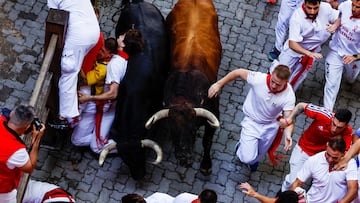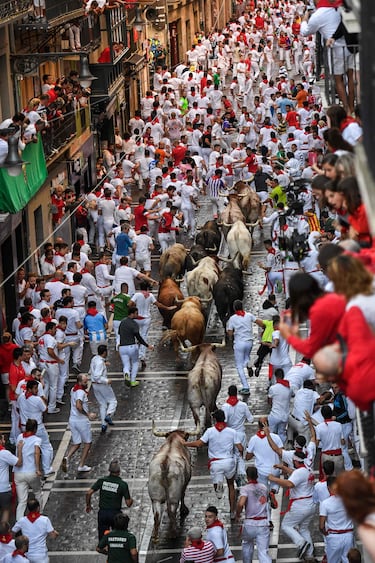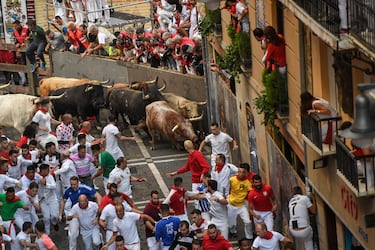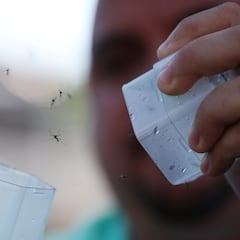How dangerous is it to run with the bulls in Pamplona?
Every year, thousands of people try their luck by running with the bulls at the San Fermín festival in Pamplona. Is it safe? Should you leave it to the locals?

Saturday’s Chupinazo signaled the start of this year’s San Fermines in Pamplona, northern Spain, kickstarting nine days of fiesta, music, food and plenty of wine. The first of eight encierros, the running of the bulls, took place on Sunday. Six people were reported having suffered an injury that required medical attention in Monday’s which was timed at 2 minutes 40 seconds from start to finish - none of them were for wounds inflicted by the bulls’ horns.
From yesterday to next Sunday, thousands of revellers will line the route through the old part of the city, from the starting point - the bull pens in Santo Domingo and along the 875-meter route to the bull ring, the end point. Most will be watching from the safety of their balconies while others will experience the exhilarating rush of adrenaline from running alongside the six bulls - not for the faint-hearted or those who are physically out of shape.
Each encierro lasts an average of 2:30 minutes - each one as unpredictable as it is exciting. The fastest encierro in recent years was recorded at 2 minutes 5 seconds in 2015 - marginally slower that the record, 1 minute 50 seconds set in July 1975.
El Riau Riau de #SanFermin no tiene igual pic.twitter.com/OXbXn4KAUF
— Navarra Hoy (@navarra_hoy) July 6, 2024
Party time in Pamplona
Bulls have always occupied a special place in Spanish culture and while bullfighting as a spectator sport has lost its appeal with younger generations of Spaniards, San Fermines, the annual fiesta in Pamplona is more popular than ever.
Like all bullfighting festivals, it’s a highly colorful spectacle and a big part of the attraction is the tradition. In Pamplona, bullfighting festivities date back to medieval times, the bull run, by far the most famous in Spain, was introduced in the late 17th Century. There are other bull runs in mainland Spain but none bigger or anywhere near as thrilling as San Fermines.
🔴 La salida de los gaiteros desata el fervor entre los congredados en la plaza tras el Chupinazo.#SanFermín2024 #Sanfermines2024 #SanFermín #Pamplona #Chupinazo #Navarra pic.twitter.com/JbZ22nb0DV
— Diario de Noticias (@NoticiasNavarra) July 6, 2024
Celebrations start at 12 noon local time on Saturday 6 July (5 a.m. EDT / 3 a.m. PDT) and continue for a week. For Pamploneses and Pamplonesas, it’s their very own fiesta, the big annual event but San Fermín also attracts tourists from all parts of Spain and abroad. For different reasons. For most, it’s exactly what a fiesta should be about - a time to relax, eat and drink with friends, enjoy life and forget about the troubles of the world.
Others meanwhile are quite happy to soak up the atmosphere and observe, watching any or all of the eight encierros, the early morning bull runs which start at the corral and end at the bullring. Each encierro is broadcast live from 8 a.m. on state television, then meticulously dissected to slow motion footage of the action back in the studio.
Braver souls head to Pamplona to sprint down the city’s narrow streets alongside the bulls - the riskiest activity of all during San Fermines. The one thing that unites all is the uniform - white shirt, white trousers, red neckerchief, red faja (a sash, tied on the left) - all of these can be bought locally, plus sturdy, comfortable shoes - not sandals and there will be a lot of broken glass lying around.
El primer encierro de #SanferminesRTVE reunió a más de 1,1 millones de espectadores (68,4 %) en @La1_tve y Canal 24 horas.
— RTVE Comunicación y Participación (@RTVE_Com) July 8, 2024
🔹'La mujer rey' logró más de 1,4 millones de espectadores (13,7 %).
🔹El Tour reunió a más de tres millones de personas (10,4 %).https://t.co/ji3Rg6oxAv pic.twitter.com/E8049YT0RH
How dangerous is it to run with the bulls during San Fermines?
It is potentially very dangerous for a number of reasons. Most of the runners are either local or have years of experience and first-hand knowledge of what can go wrong, passed down from generation to generation. They know the route, the corners where pile-ups can happen, how long it will take to get from A to B, how much time they can actually spend running alongside the bulls, when to retire to the side of the road and most importantly, what to do, and what not to do, if something goes wrong.
For the eight encierros, the morning starts at around 7 a.m. Access to the route closes at 7:30 and the encierro starts at 8 a.m. That half hour or so is generally used to limber up, loosen muscles and focus on the run.
Many runners carry a rolled-up newspaper which will be used to distract a bull that gets separated - the biggest danger of all during the bull run. If one of the six bulls gets separated from the rest, it will become frightened, unpredictable and will charge at anything in its path.
These are immense beasts, much bigger and stronger than they seem on television, and their horns are lethal - a cornada can rip open flesh and rupture vital arteries in a fraction of a second. And it is not just yourself that you have to look after - it’s making sure that you are not putting everyone else at risk as well.
Running with the bulls takes skill - corredores have to be aware of how far away the bulls are at all times. When they are released from the corral, the bulls will be behind you but within seconds, they will be within metres and charging towards you. So you have to be conscious of the distance between yourself and the bulls - and at the same time, aware of what is in front of you... most injuries happen when someone slips, falls over and inadvertently trips the person behind. The run from start to finish can last anything from two to two and a half minutes.
CRÓNICA | Sexto encierro de San Fermín emocionante y rápido con los toros de Núñez del Cuvillo https://t.co/ThSx7xEK7O #Encierro6RTVE pic.twitter.com/XwFVcRrLfl
— RTVE (@rtve) July 12, 2019
Running with the bulls: etiquette and tips
It is advised not to have any objects or belongings that could put yourself and others at risk - no cameras, video cameras, backpacks, bags... a rolled-up newspaper is allowed.
If you fall, stay on the ground and cover your head with your hands. Do not look up or try to get up until the bulls have passed.
Don’t run behind the bulls once they have passed. This could distract one of them, or force them to turn around.
It is advised not to touch the bulls although some experienced runners will place their hand on the bull’s back for a couple of seconds.
Spread out as soon as you enter the bullring to avoid a pile-up at the entrance. Officials will usher the bulls into their pen.
Another of the dangers of San Fermín is alcohol - it’s all too easy to get caught up in the party atmosphere, forget how much you’ve had to drink and decide to run with the bulls with little or no sleep. Organisers have seen this thousands of times, so anyone looking the worse for wear could be denied access.
On the whole, San Fermines is extremely well organised and most of the bull runs in recent years have been clean. There are also always medical services on hand to treat anyone with cuts, bruises...

Peligroso el tercer encierro de San Fermín… pic.twitter.com/SDA6NvmuXS
— César Moreno (@CesarMorenoH) July 9, 2023
There have been no major incidents during San Fermines in recent years but the most serious injuries have been sustained by tourists, generally North American or Australian. Foreigners/non-residents who require medical attention might he hit with bill...
Of the one million spectators, and more than 20,000 participants who travel to Pamplona, many have been drawn to the fiesta because of novelist, Ernest Hemingway who experienced the event for the first time in 1923.
With his vivid descriptions of the encierro and the corrida (the bull fight) in Fiesta, the Sun Also Rises, Hemingway brought the previously small, local festival to international attention, and although he never ran with the bulls himself, planted the seed in the minds of millions of young men to do just that.

More than half of the participants in the encierros are foreign, with nearly a quarter coming from North America and another 15% coming from Britain, Australia and New Zealand. Two out of every three runners are taking part for the first time. Don Ernesto certainly put this small Navarrese town on the map.
On the face of things, it would seem that running with a group of bulls through a narrow street would be dangerous, even bordering on suicidal, but the reality is that there are very few serious injuries sustained in the event.
SEGUNDO ENCIERRO DE SAN FERMIN
— Navarra Hoy (@navarra_hoy) July 8, 2022
6 personas heridas, ninguna por asta, han sido trasladadas al Hospital Universitario de Navarra,. Esta noche te los contamos todo. A las 22.15 en #NavarraHoyETB pic.twitter.com/KJu82se0tZ
The dangers: pile-ups and isolated bulls
Every year there are between 50 and 100 injuries, the vast majority of which are minor, to the point where they do not require a trip to the hospital. The most common of these types of injury are being stamped on or falling down, or perhaps running into a stationary object.
When runners fall there is always a risk of a pile-up, particularly at the entrance to the bullring itself, which is much more narrow than the previous street. In fact, this is the place where the overwhelming majority of serious injuries have occurred, with crowd crush augmenting the possibility of asphyxiation or goring by the following bulls.
👉 Ernest Hemingway in Pamplona.
— Pablo Anaya (@panayat) July 7, 2022
✅ De Paris a Pamplona en busca de la inspiración para escribir sus crónicas y su novela de "The sun also rises" pic.twitter.com/iGzAPOLw9w
Since record-keeping began in 1910, there have been only 15 deaths at San Fermín, with the only American being Matthew Tassio, a 22-year-old from Chicago who was gored in 1995 and died of blood loss.
Related stories
The last person to have lost their life was Daniel Jimeno Romero, a Madrid native who was gored to death in 2009. It is worth note that of the 15 who have been fatally injured, six were in the bullring itself and only one was from a cause other than goring. In 1977, local man José Joaquín Esparza was suffocated at the bottom of a pile-up just at the entrance to the bullring.
If you are planning to go to Pamplona, statistics would indicate that as long as you stay away from the entrance to the bullring, you will probably be okay. But the best bet is to do what the great man himself did. Drink from the safety of a bar and leave the running to others.


Complete your personal details to comment